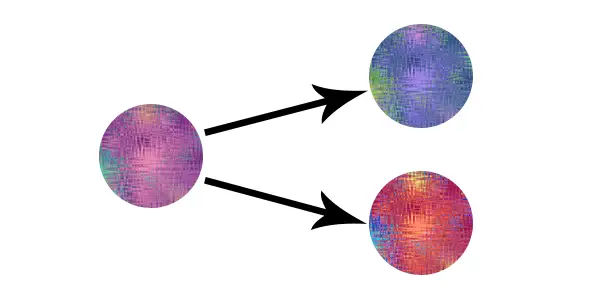Fantasy Science Pt. 10: Quantum Locking In DOCTOR WHO

Radha has a PhD in theoretical quantum physics. Apart from…
Quantum states. Superposition. Time travel. Have you heard terms like these flying around the science fiction sections of the film world? Have you ever wondered just how accurately these films portray real science? Well, my friends, today is your lucky day: this column, Fantasy Science & Coffee, aims to bridge the gap between science and science fiction in films and popular culture. My hope is to explain things in a fun way – like we’re chatting over coffee.
You may be thinking: who is this person, why does she think she can explain science, and why the heck would I want to have coffee with her? Well, I’m Radha, a researcher in India, currently pursuing a PhD in theoretical quantum physics. I quite like hot beverages. I’ll also pay.

In this tenth part of the series published on the second and fourth Tuesdays of every month, we are going to look at quantum locking in the light of Doctor Who and the Weeping Angels. Let’s begin.
Quantum Locking and the Weeping Angels
Don’t blink. Fans of the television show Doctor Who are no stranger to these wise words. They refer to villainous creatures called Weeping Angels, who’ve been around since nearly the beginning of the universe. The Angels appear to be stone statues in winged, humanoid form. The interesting thing about them is that no one quite knows what they really look like; observing them petrifies the Angels into statue form in a process referred to as quantum locking. This applies if they look at one another as well: that’s why they’re often seen to be covering their own eyes, as though they’re weeping.
The Angels are far from harmless moving stone statues. They send their victims back in time, feeding off the potential energy of what would have been the victim’s normal life. In the words of the Tenth Doctor:
Fascinating race, the Weeping Angels. The only psychopaths in the universe to kill you nicely. No mess, no fuss, they just zap you into the past and let you live to death. The rest of your life used up and blown away in the blink of an eye. You die in the past, and in the present they consume the energy of all the days you might have had, all your stolen moments. They’re creatures of the abstract. They live off potential energy.
The one advantage a potential victim has is that the Angels cannot move when they are being observed. Hence the advice: don’t blink.
The Weeping Angels were first introduced in the tenth part of Series 3, in an episode by Steven Moffat called Blink. In this episode, the Tenth Doctor and his companion are accidentally trapped in 1969 without his time/space machine, the Tardis. They leave written and video recorded warnings for a girl named Sally Sparrow who finds herself, in 2007, stumbling across the missing Tardis, and facing the Angels. The Doctor gives her the task of sending the Tardis back to 1969, with instructions on how to deal with these villains.
Here’s what the Doctor says to Sally Sparrow about Angels and quantum locking, warning her not to blink when they are around:
The Quantum Zeno Effect
The interesting thing to note about these Weeping Angels, is that there’s a very real basis behind their explanation. While there aren’t psychopathic statues intent on sending you back in time to live to death, there are ways to ‘lock’ a quantum state.

Before we get to the locking bit, let’s talk about quantum states. You can think of a quantum state as a superposition of possibilities that a quantum particle can take. For instance, suppose you get your hand on a really cool marble that obeys the laws of quantum physics. It has a very special characteristic: it can become one of two colours, red or blue – each with a 50% chance – when you look at it. That is, prior to observation, it’s a superposition of these two colour possibilities.
Suppose you look at your marble and it becomes red. Since quantum states aren’t stable and tend to decay; after a short time it will return to a superposition of red and blue. You’d have to look at it again for it to become a single colour.
Now, suppose you really, really like the colour red. Is there a way that you can keep the marble red for a longer period of time? The answer is yes. While you wouldn’t be able to ‘lock’ it indefinitely, the quantum Zeno effect will allow you to keep your marble red long enough to impress a date.
The key lies in repetitive, frequent measurements, or in this case, “looks”. Once you look at the marble for the first time and it becomes red, don’t allow it to decay back into the superposition. You see, after an observation, it takes the marble a bit of time to return to the 50-50 superposition. Suppose the time required to return it to its initial superposition is five minutes. At three minutes, the superposition may be 70-30 in favour of red, which means if you look at the marble again after three minutes, there will be a higher chance that it will turn red. The chance is even higher at two minutes, with odds at, say, 80-20. In this way, you can eliminate the chance that the marble will turn blue altogether, by continuously measuring it!
Thus, the quantum locked nature of the Weeping Angels is quite believable in the realm of quantum physics. If you spot a rogue Angel as you go about your day, then heed the wise words of the Tenth Doctor:
Don’t blink. Blink and you’re dead. They are fast. Faster than you can believe. Don’t turn your back. Don’t look away. And don’t blink. Good Luck.
More to Explore
Resources
Articles
Forbes: This Is How Science Proves You Can Kill The Weeping Angels From ‘Doctor Who’ (2018)
Futurism: How Schrödinger’s Cat Helps Explain the New Findings About the Quantum Zeno Effect (2017)
PhysOrg: ‘Zeno effect’ verified—atoms won’t move while you watch (2015)
Note: the term ‘quantum locking’ has been used elsewhere in the real world for a phenomena involving superconductors, but that sort of quantum locking doesn’t have anything to do with the way Weeping Angels seem to work. However, a curious reader may look at: io9: Quantum locking will blow your mind — but how does it work?(2011)
Does content like this matter to you?
Become a Member and support film journalism. Unlock access to all of Film Inquiry`s great articles. Join a community of like-minded readers who are passionate about cinema - get access to our private members Network, give back to independent filmmakers, and more.
Radha has a PhD in theoretical quantum physics. Apart from research, she consults on sci-fi screenplays/books. In her free time, she cosplays and irritates her three cats. Bug her on Twitter: @RadhaPyari












